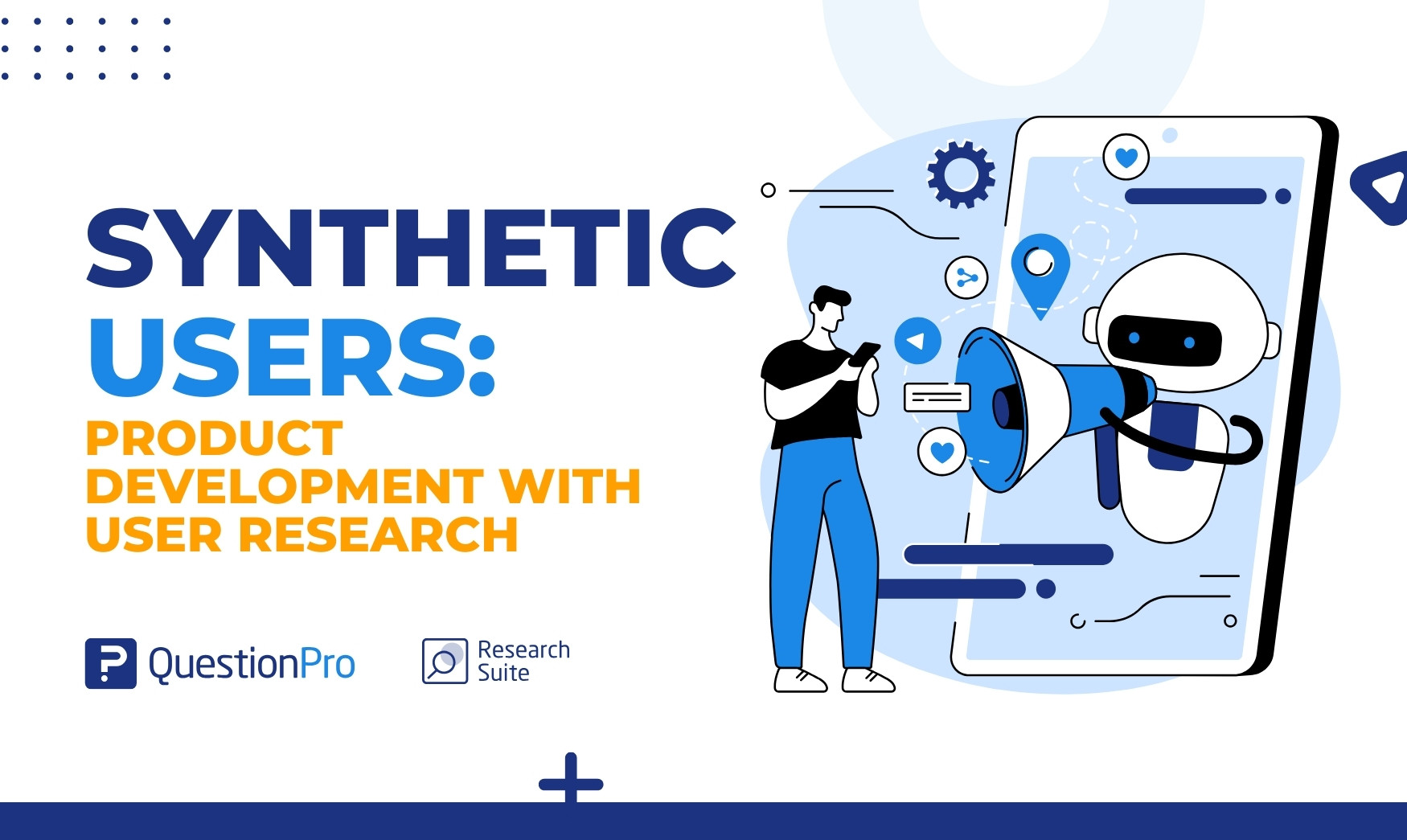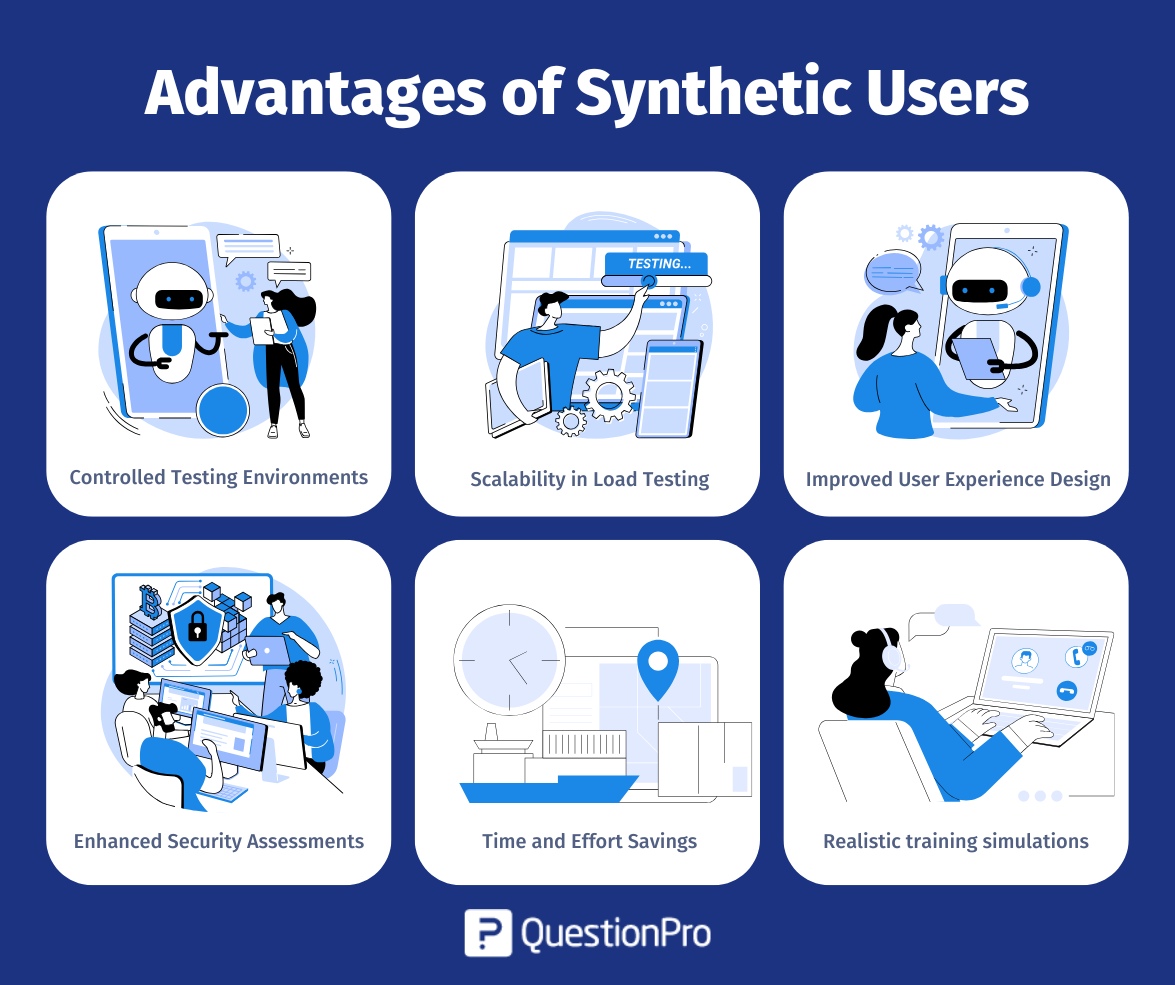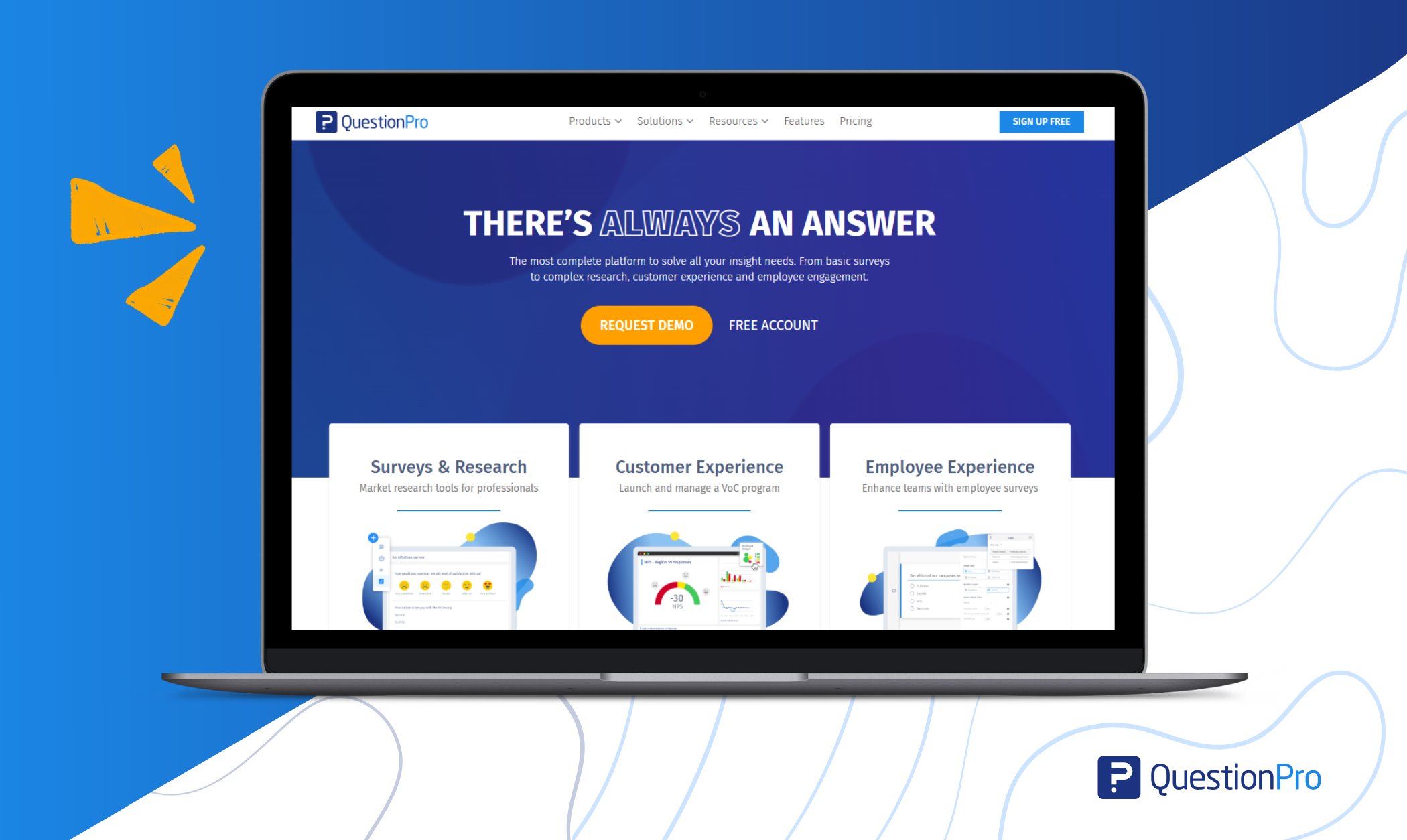
Product research is changing, and one key driver behind this transformation is the rise of artificial intelligence. At the core of various AI-driven technologies, synthetic users represent one of the most significant disruptions in the field of market research.
These AI-powered virtual participants have the potential to reshape research methodologies, offering both advantages and challenges. We invite you to keep reading to discover why integrating this new technology can be a game-changer and learn how to use it in your research.
What is a Synthetic User?
Synthetic users are artificial or computer-generated entities that replicate human behavior and interactions in various contexts, such as user research, testing, or product development. These users aim to emulate the information a real user would generate based on past behavior patterns and predictive models, combining artificial intelligence, machine learning, and big data to deliver the most reliable results possible.
You can use artificial intelligence (AI) to create synthetic users. These “fake users” can copy real users’ actions and preferences, which provides valuable information without needing real people.
In user research and product development, you can use them for:
- Test and evaluate software, websites, or applications.
- Collect feedback on user interfaces and features.
- Gather data on user preferences and behaviors.
- Conduct scenario-based simulations for product testing.
- Provide insights into the user experience.
Synthetic users are gaining popularity in user research because of advancements in natural language processing (NLP), large language models (LLMs), and AI in market research.
These AI-driven virtual participants offer a new way of product testing and feedback collection alongside traditional qualitative research methods. They can be customized for different audiences and give targeted feedback to improve products and services.
Synthetic Users in Market Research
You can benefit from AI-powered market research tools, such as synthetic users, to gather insights and validate concepts. These new technologies present opportunities to better understand your target audience with advantages not available in more traditional methods. Some benefits of implementing synthetic users include:
- Improved time and cost efficiency: Synthetic users allow research to scale by generating larger data sets.
- Faster data collection: With synthetic users, data gathering becomes significantly quicker than traditional methods.
- More controlled segmentation: The parameters defining synthetic users can be particular, enabling greater control over the collected data.
- Reduced logistical needs: Since synthetic users are virtual, operational requirements are minimized, there’s no need to invest in coordinators, field surveyors, or physical spaces for research.
These technologies allow researchers to obtain insights more efficiently, not only in terms of time but also in human resources. This shift enables a stronger focus on analyzing results and implementing valuable project solutions.
However, it’s essential to acknowledge the challenges and concerns associated with using synthetic users in research. There is an ongoing debate regarding the ethical implications and the validity of synthetic data. Nevertheless, this is a rapidly evolving field that continues to demonstrate improvements.
These tools help identify market-friendly features and refine customer preferences. Companies leveraging AI in research can gain valuable insights, validate their ideas, and develop better products and services for customers. As a result, this is a field worth exploring to enhance current organizational processes.
Applications of Synthetic Users
Synthetic users are being used across a wide range of industries and research fields. Synthetic users have a range of real-world applications, including:
- Training language systems.
- Developing self-driving cars.
- Detecting fraud in financial institutions.
- Testing new ideas and products without putting personal data at risk.
- Researching user.
- Enhancing machine learning models.
- Simulating real-world scenarios for testing.
- Offering an affordable alternative to real-world data.
In the context of user research and product development, artificial users can assist you in:
- Discovering product features and market fit
- Refining customer preferences to enhance product offerings
- Simulating user interactions and gaining insights into customer preferences and behaviors
- Identifying areas for improvement and optimizing the user experience.
This allows you to customize your products and services better to meet your customers’ unique needs, ultimately increasing customer satisfaction and loyalty.
1. Uncovering Features and Market Fit
Synthetic users provide a unique view of your product, helping you gain insights from the tests done by their AI-driven counterparts.
When you simulate user interactions, synthetic users can help you figure out how well your product fits the market by giving you insights into what customers like and how they behave. This helps you discover the best product features for your target market and make improvements accordingly.
There are several benefits to uncovering these features, including:
- Getting a deep understanding of your product’s abilities and functions.
- Identifying unique selling points and competitive advantages.
- Helping your product stand out from competitors in the market.
- Effectively communicating the benefits and value to your customers.
- Assisting in studying and investigating the market to find the best fit for it and to learn what customers want.
Using synthetic users for these purposes can help you make more informed decisions and ultimately create better products and services.
2. Fine-Tuning Customer Preferences
You can use AI insights to fine-tune customer preferences and improve your products. Synthetic users can help with product testing and give you insights to understand your customers better.
Benefits of refining customer preferences include:
- Adaptability: It keeps your offerings aligned with evolving customer expectations, ensuring your continued relevance.
- Enhanced Customer Satisfaction: Meeting customer needs increases satisfaction, fostering loyalty and positive word-of-mouth.
- Increased Efficiency: Focusing on popular features streamlines development, reducing costs and time-to-market.
- Creativity and Competitive Edge: Understanding preferences fuels innovation and helps you stand out in a competitive market.
- Improved Decision-Making: Informed by customer insights, decisions become more data-driven, minimizing risks and maximizing success.
Advantages of Synthetic Users
Synthetic users offer several advantages over live user testing sessions, such as time and cost efficiency and the ability to target specific audiences for more meaningful feedback. When conducting user testing, you might face time and budget constraints, and finding the right people to participate can be challenging.
Using synthetic users is a cost-effective and efficient way to test products because it doesn’t demand as many resources as live user testing. Here’s why it’s a good choice:
- You can customize them for specific groups, getting feedback that helps improve your products.
- They reveal what customers like and how they behave by simulating user interactions.
- They add to the data you gather from real users, giving you a complete picture of your target synthetic audience.
Other benefits are:

01. Controlled Testing Environments
In controlled testing environments, you need to evaluate applications and systems accurately. Synthetic users are excellent for this purpose and offer you the following benefits:
- You can have precise control over the testing conditions.
- External factors that could impact the results are eliminated.
- The test execution is consistent.
- Testing scenarios are accurate and repeatable.
02. Scalability in Load Testing
Load testing is important to see how your system performs under heavy user traffic. Synthetic users make it easy to simulate large numbers of users at the same time.
This helps you test your system’s capacity and make sure it can handle high loads without slowing down or crashing.
Synthetic users also help spot performance issues or weak areas that need fixing. By using them in load testing, you ensure your system stays reliable, even during peak times.
03. Improved User Experience Design
In UX design, it’s essential to comprehend user behavior and preferences. Synthetic users play a key role in improving design, offering advantages like:
- They mimic user interactions and preferences.
- They help identify user pain points and preferences.
- They enable you to make iterative design improvements.
04. Enhanced Security Assessments
In security assessments, you can rely on synthetic users to help identify vulnerabilities and threats. They have various benefits, including:
- Simulating different attack scenarios.
- Evaluating system security in controlled conditions.
- Identifying vulnerabilities and weaknesses.
- Improving overall cybersecurity measures.
05. Time and Effort Savings
One major advantage of using synthetic users is the time and effort saved, especially in qualitative research. These AI participants can automate repetitive tasks, follow personal rules, and reduce the need for manual testing.
They also streamline data collection and analysis, giving researchers more time to focus on insights. Synthetic users provide a unique overview of user behavior, help uncover features that matter, and offer a scalable way to track success metrics, all without the cost and complexity of live user testing.
06. Realistic Training and Education
Regarding your training and education needs, synthetic users can be incredibly useful. They can help you by:
- Creating realistic training simulations.
- Allowing you to have hands-on learning experiences.
- Providing a safe environment for developing new skills.
- Making your training programs more effective and efficient.
Challenges and Considerations
While synthetic users offer numerous benefits in user research, they also present unique challenges and limitations. Here are some of these challenges:
- Generating synthetic data that accurately mirrors real-world complexity which may result in inconsistencies.
- Monitoring users, both real and synthetic, can be costly and time-consuming at the same time.
- Accuracy issues when trying to understand user behavior from synthetic data.
- Gaining acceptance and trust in using synthetic users for study purposes.
Despite these challenges, synthetic users can be a valuable tool in user study when used wisely and with careful consideration of their limitations. To overcome these challenges, it’s important to acknowledge the difficulties in accurately simulating user behavior, capturing emotional reactions, and addressing ethical concerns when using them for research.
1. Data Privacy and Ethics
When it comes to data privacy and ethics, you need to be careful with synthetic users. Here are some important things to think about:
- Ensure that synthetic users’ data doesn’t affect real user privacy.
- Follow ethical guidelines when collecting and using synthetic datasets.
- Be aware of potential biases in how synthetic users behave and interact.
- Keep sensitive information used to create synthetic users safe.
2. Accuracy and Realism
To make synthetic users accurate and realistic, consider these challenges:
- Ensure that synthetic users really act like real users.
- It’s hard to capture their emotions and thoughts accurately.
- Be cautious about synthetic users creating weird or biased data.
- Use AI and machine learning to make synthetic users more realistic over time.
3. Maintenance and Updates
When it comes to maintaining and updating synthetic users, keep these things in mind:
- Regularly update synthetic user profiles to match how real users behave.
- Make sure your synthetic users stay current and relevant.
- Deal with issues that can pop up when you update software or AI models.
- Balance the maintenance effort with the need for accurate, up-to-date synthetic users.
4. Cost Considerations
While synthetic users can save money, there are still financial factors to consider:
- There’s an initial cost for the technology and tools to create them.
- Weigh the savings from using them against their effectiveness.
- Make cost-effective decisions about when to use them and when to use live user testing.
Creating Synthetic Users For Your Research
To create synthetic users, you can combine data-driven insights with automation and artificial intelligence. This involves collecting behavior patterns from real users, then simulating those behaviors using programmable synthetic data generation tools or AI models.
1. Gather Behavioral Data By Using QuestionPro Surveys
Before you create synthetic users, you need a foundation of real user data. With QuestionPro, you can design targeted surveys to collect insights on user preferences, navigation habits, decision-making triggers, and pain points. This data becomes the blueprint for building synthetic users who replicate realistic behavior patterns.

Whether you’re researching product interactions, customer journey steps, or UX decisions, QuestionPro surveys help you collect:
- Intentions and feature usage preferences.
- Scenario-based responses.
- Demographic or persona-specific behaviors.
- Very specific audiences.
These insights can then be used to generate lifelike synthetic users for future testing and simulation.
2. Scripting and Automation
Once you have data from real users, scripting tools can simulate those behaviors. With automation scripts, you can replicate tasks such as navigating a website, submitting a form, or testing a feature without involving a live participant.
Key benefits of this approach:
- High precision in replicating user flows.
- Ideal for repetitive or controlled testing scenarios.
- Helps QA, UX, and product teams validate features efficiently.
You can design test scenarios based on patterns identified from QuestionPro survey responses, making the simulations more realistic and context-aware.
3. Artificial Intelligence and Machine Learning
AI and Machine Learning (ML) are key technologies for building synthetic users that adapt and evolve. Unlike simple scripts, AI models can simulate realistic user behavior over time.
You can train these models using data from QuestionPro surveys. This includes insights into user preferences, habits, and reactions to different product features.
Once trained, AI can predict how users might behave in various situations. It helps you simulate real-world interactions and test different user flows without needing live participants.
As these models learn and improve, they provide more accurate simulations. This enables better testing, faster iteration, and deeper insights into what users want, based on real survey data.
Tools and Technologies for Implementing Synthetic Users
To use synthetic users in your research, you can combine Generative AI platforms and powerful survey tools. Together, these technologies allow you to simulate user behavior, explore different scenarios, and gather insights all without involving real participants at every stage.
With QuestionPro, you can start by collecting high-quality user data through customizable surveys. This behavioral data becomes the foundation for training AI models or scripting user simulations. Once synthetic users are created, you can run iterative tests, simulate feedback, and validate concepts more efficiently.
By integrating these tools into your workflow, you get a broader view of user behavior and make smarter, faster decisions on product design, usability, and customer experience.
01. Generative AI Platforms
Generative AI platforms create synthetic users by modeling and simulating how users behave in different scenarios. These AI models learn from data like the kind you collect using QuestionPro surveys and generate feedback or simulate decisions just like real users would.
Popular generative AI platforms include:
- Gemini
- ChatGPT
- AlphaCode
- GitHub Copilot
- Deepseek
- Claude
- Cohere Generate
- Synthesia
Researchers can combine the output of these AI tools with real-world insights from QuestionPro to get deeper user understanding, test multiple hypotheses, and see how different user segments would react to new products or features.
02. Integrating Synthetic Users into Existing Research Processes
Incorporating synthetic users into your current research process is easier when you already use a survey platform like QuestionPro. Start by defining your research goals and designing surveys that capture real user preferences, behaviors, and challenges.
Once you have this synthetic test data, you can train AI models or design scripts that mirror your target audience. The synthetic users generated from this process can then be tested under different conditions to simulate feedback, uncover usability issues, or stress test new features.
The insights will help you:
- Make better product design decisions.
- Improve the user experience.
- Understand customer preferences better.
- Identify pain points and areas for improvement.
- Optimize product-market fit faster.
By automating parts of the research process with synthetic users, you save time, reduce costs, and increase your capacity to test and iterate. Continual analysis using both synthetic and real-user data from tools like QuestionPro ensures your decisions are grounded in diverse, actionable insights.
Best Practices for Using Synthetic Users in User Research
To maximize synthetic users in your user research, follow some essential practices. These include balancing real data and AI insights and ensuring you use synthetic users ethically and responsibly. These practices will help you maximize synthetic personas while minimizing potential challenges.
Here are some specific strategies for using synthetic users in your research:
- Set up alerts to keep an eye on how your system is performing.
- Run tests from different locations to get a broader perspective.
- Understand and assess the reports generated by synthetic monitoring.
- Use both synthetic and real user data to get a complete picture of the user experience.
- Regularly review and analyze the data to spot areas for improvement.
By following these best practices and strategies, you can use synthetic users effectively and responsibly in your research.
Ensuring Ethical and Responsible Use of Synthetic Users
Using synthetic users ethically and responsibly is crucial to maintaining trust and credibility in your user research. You should be aware of privacy issues, data security, and possible bias in the data generated by them.
Consider the following potential ethical concerns when using synthetic users in your research:
- The risk of manipulating data
- The possibility of using data unethically
- The potential to target vulnerable populations with synthetic personas
To address these ethical concerns, you can take the following steps:
- Establish ethical guidelines to ensure responsible use.
- Ensure data security and privacy to protect the information.
- Use data generated by these users responsibly, considering its potential impact on individuals and society.
By following these guidelines and strategies, you can ensure that the users are used ethically and responsibly in your research.
Conclusion
Synthetic users are very helpful in user research. They save time and money, let you focus on certain groups, and offer a new way to test products and gather feedback. Even though they have some limitations, like not understanding emotions and ethical concerns, these users can give useful insights that go along with real people’s opinions.
If you use the proper methods and technology, you can make the most of these users to improve your research and improve your customers’ products and services.
QuestionPro Research Suite is a popular survey software platform that offers a range of features and tools to facilitate data collection and analysis for researchers. Researchers can leverage this versatile survey software to conduct user research with synthetic users.
The platform’s features, including survey creation, audience targeting, data collection, and analytics, make it a valuable tool for gathering insights and improving products and services based on synthetic user feedback.
Researchers can use it to efficiently manage their research efforts and make informed decisions to enhance the user experience.
Frequently Asked Questions(FAQs)
Answer: Yes. Tools like QuestionPro allow you to gather detailed behavioral and preference data through surveys, which can then be used to train AI models or scripts that simulate synthetic users realistically.
Answer: Absolutely. Synthetic users can be used to simulate open-ended feedback, scenario-based interactions, and even persona-driven behaviors making them a useful complement to traditional qualitative methods.
Answer: Yes. By simulating and analyzing user behavior early in the development cycle, businesses can fine-tune features, align with user expectations, and deliver more personalized, satisfying experiences.
Answer: Yes. They simulate user flows, highlight interaction patterns, and expose pain points, allowing design teams to refine interfaces before exposing them to real users.
Answer: Start by defining research goals and collecting behavioral data using tools like QuestionPro. Then, use AI platforms or automation scripts to model synthetic users and incorporate them into your testing workflows.
Answer: Potential risks include data misuse, algorithmic bias, and lack of transparency. It’s essential to follow ethical guidelines, secure sensitive inputs, and use synthetic insights responsibly to protect both user trust and research validity.







